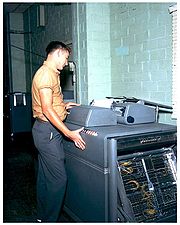
IBM 407
Encyclopedia

IBM
International Business Machines Corporation or IBM is an American multinational technology and consulting corporation headquartered in Armonk, New York, United States. IBM manufactures and sells computer hardware and software, and it offers infrastructure, hosting and consulting services in areas...
tabulating machine
Tabulating machine
The tabulating machine was an electrical device designed to assist in summarizing information and, later, accounting. Invented by Herman Hollerith, the machine was developed to help process data for the 1890 U.S. Census...
s dating back to the days of Herman Hollerith
Herman Hollerith
Herman Hollerith was an American statistician who developed a mechanical tabulator based on punched cards to rapidly tabulate statistics from millions of pieces of data. He was the founder of one of the companies that later merged and became IBM.-Personal life:Hollerith was born in Buffalo, New...
. It was the central component of any unit record equipment
Unit record equipment
Before the advent of electronic computers, data processing was performed using electromechanical devices called unit record equipment, electric accounting machines or tabulating machines. Unit record machines were as ubiquitous in industry and government in the first half of the twentieth century...
shop. In the late 1950s, the 407 was adapted as an input/output device on early computers, such as the IBM 650
IBM 650
The IBM 650 was one of IBM’s early computers, and the world’s first mass-produced computer. It was announced in 1953, and over 2000 systems were produced between the first shipment in 1954 and its final manufacture in 1962...
. Later, 407 print mechanisms were used in the IBM 1132
IBM 1132
The IBM 1132 Line Printer was the normal printer for the IBM 1130 computer system. It printed 120 character lines at 80 lines per minute. The character set consisted of numbers, upper-case letters and some special characters....
line printer
Line printer
The line printer is a form of high speed impact printer in which one line of type is printed at a time. They are mostly associated with the early days of computing, but the technology is still in use...
, part of the low cost IBM 1130
IBM 1130
The IBM 1130 Computing System was introduced in 1965. It was IBM's least-expensive computer to date, and was aimed at price-sensitive, computing-intensive technical markets like education and engineering. It succeeded the IBM 1620 in that market segment. The IBM 1800 was a process control variant...
computer system.
The 407 read punched card
Punched card
A punched card, punch card, IBM card, or Hollerith card is a piece of stiff paper that contains digital information represented by the presence or absence of holes in predefined positions...
s, totaled fields on the cards, made simple decisions, printed results, and, with the aid of a summary punch, output results on punched cards that could be input to other processing steps.
The operation of the 407 was directed by the use of a removable plugboard
Plugboard
A plugboard, or control panel , is an array of jacks, or hubs, into which patch cords can be inserted to complete an electrical circuit. Control panels were used to direct the operation of some unit record equipment...
control panel. Exit hubs (impulse emitting) on the control panel are wired to entry hubs (impulse accepting) for the task to be done (see photos). There are hubs for each card column (at both reading stations), print position, counter digit, and so on. Logic tests were also available.
Each input card was read at two successive reading stations. Thus, for example, fields in a card could be compared with the following card and, should a change be detected, say in invoice number, totals could be printed. Unlike earlier IBM tabulating machines, which had one read brush per column at each read station, the 407 had 960 brushes at each station, one for each possible hole in a punched card. Cards were held in position during each read cycle and the per digit pulses needed were generated using commutators, one for each column. This allowed the card to be read more than once at each station, for greater programming flexibility.
For printing, the 407 used wheels, an improvement over earlier tabulators that used print bars. The wheels were stationary until a character impulse was to be printed; the wheel then rotated to one of 47 positions for printing, was driven against the plate, and then emitted an impulse (called "echo") for the character actually printed. The control panel would be wired so the echo impulses were accumulated for totals; report totals then reliably reflected what had actually been printed.
The 407 was available in a model that could read 100 cards per minute, and one reading 150 cards per minute. The former had a relay which would inhibit every third card feed cycle (giving the machine a characteristic "shrink-shrink-thunk" sound). It was possible to insert a folded card between that relay's contacts to "overclock" the slower model to the faster speed.
In 1976 the IBM 407 Accounting Machine was withdrawn from marketing.
External links
- Columbia University Computing History: The IBM 407
- IBM Archive: IBM 407 photo (in photo, the box at left side is not part of the basic 407)
- IBM Archive: IBM 407 Control Panel photo
- audio clip of IBM 407 in operation

